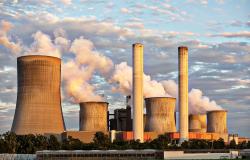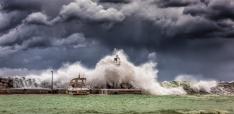Ten Years After the Fukushima Disaster: Nuclear Energy in the Times of Climate Change

Karola Klatt explores Japan’s contradictory moves towards a nuclear free future.
Ten years after the devastating tsunami and triple core meltdown at the Fukushima Daiichi nuclear power plant on March 11, 2011, Japan is still struggling with the fallout. An exclusion zone of approximately 30 kilometers may only be entered with special permission and when wearing protective clothing. Decontamination measures in areas further away have largely been completed and residents have been allowed to return but some 20 million cubic meters of contaminated soil have accumulated.
Storage of contaminated water is also increasingly difficult. More than 1.2 million tons of cooling and groundwater have been pumped out of the damaged reactors, filtered and decanted into numerous tanks on the reactor site. Every day, about 170 tons of contaminated water are added. Because the storage capacity is running out, the operating company Tepco wants to release the water into the sea. If one believes its statements, there is no longer any danger to the environment, but Japanese fishermen fear lasting damage to their international reputation.
A quiet return to nuclear energy?
After the disaster, all 54 Japanese nuclear reactors were taken off the grid. Since then, the electricity gap has been covered primarily by fossil fuels. However, between 2017 and 2019, 9 reactors came back online, and nuclear energy now contributes 7.5 percent of the energy mix. In October, new head of government Yoshihide Suga announced climate neutrality by 2050. But the country's forested and mountainous topography severely limits the potential for expanding wind and solar power, and also makes it expensive. Can Japan achieve its climate goal without having to restart many more nuclear power plants?
Regarding the changes from the Japanese government's fourth to its current fifth energy strategy plan, the country report of the Bertelsmann Stiftung’s Sustainable Governance Indicators (SGI) states: “The basic proportions envisioned for the country’s 2030 energy mix remain unchanged, including the goal of a 22 to 24 percent share for renewables and 20 to 22 percent for nuclear energy. This is ambitious, and will be hard to achieve if many nuclear reactors remain shut down.“
Modular small power plants instead of large reactors
Many industrialized countries rely on nuclear power to achieve their climate goals. For example, U.S. President-elect Joe Biden's plan to combat climate change includes the item “Defining the Future of Nuclear Power. We must consider all low-carbon and zero-carbon technologies to address the climate emergency that threatens our communities, economy, and national security.”
In the U.S., as well as many other old and new nuclear energy countries, high hopes are pinned on small modular reactors (SMRs) that can generate up to 300 megawatts of electricity per module. The modules are prefabricated in factories and then shipped to utilities for installation in single- or multi-module plants. The first such plant has gone into operation on a ship in Russia. 72 other small modular power plants are currently under development or construction in 18 countries, according to the International Atomic Energy Agency.
Whether nuclear power is a sustainable option to decisively reduce a nation's CO2 emissions is highly controversial among researchers. A study last year, for example, makes clear that in statistical analysis of data over a 25-year period, nuclear power is associated with slightly lower CO2 emissions but only in wealthier countries. In poorer countries nuclear power is actually associated with higher CO2 emissions. In contrast, the link between renewable energy and a reduction in CO2 emissions was seven times stronger. A study from this year emphasizes that nuclear power is not even suitable as a transitional or bridging technology to protect the climate because of the high risks involved. A concern voiced in both studies, is that nuclear power appears to hinder the expansion of renewables: most countries choose either to invest heavily in nuclear power or to invest in renewables, but do not manage to do both equally well.
Energy strategies often not very realistic
Of the twenty-odd countries where nuclear power accounts for more than 10 percent of the energy mix, only six have decided to phase out nuclear power in response to the reactor disaster at Fukushima: Belgium, South Korea, Switzerland, Spain, Taiwan and Germany. Other major nuclear energy countries merely want to curb their nuclear power generation in the next few years, such as France, the world's leading nuclear power nation where nuclear power accounts for nearly three-quarters of its energy mix. However, according to SGI country experts, the nation also lacks a realistic plan for reduction targets during its energy transition: “The country has a good record on carbon emissions overall, but this is largely due to strong dependence on an aging nuclear-energy sector. Plans to reduce the nuclear-power generation share from 75 percent to 50 percent by 2025, accompanied by a strong increase in renewables, appear unlikely to be realized in full.”
Other countries that have made good progress toward climate goals by international standards also have a high share of nuclear power in electricity generation: in Switzerland it made up around 24 percent in 2019, in Sweden 34 percent, in Finland 35 percent and in Belgium as much as 48 percent. The latter aims at phasing out nuclear by 2025, but according to the SGI country report, the regions cannot agree on a common policy for approving new power generation facilities.
Conflicting signals from Japan
The Japanese government now finds itself in a similar predicament: in September 2019, Japan's then-new Environment Minister Shinjiro Koizumi made a surprise statement that he would work on Japan's nuclear phase-out to prevent a second Fukushima disaster. This statement, which was positively received by the country's anti-nuclear movement, stands as a blatant contradiction of the restarting of nuclear facilities as well as Japan's commitment to SMR: a report by the International Atomic Energy Agency lists eight technology projects in various stages of development for the country alone.
Even though SMRs are considered much safer and more profitable overall than large reactors, a major safety risk remains: Japan has neither an interim nor a final repository for radioactive waste. The contradictory signals currently being sent by the Japanese government underscore one point: the struggle over the future of nuclear power is far from over in the country of the biggest nuclear disaster since Chernobyl.
Karola Klatt is a science journalist and editor of SGI News and the Bertelsmann Stiftung's BTI Blog.


